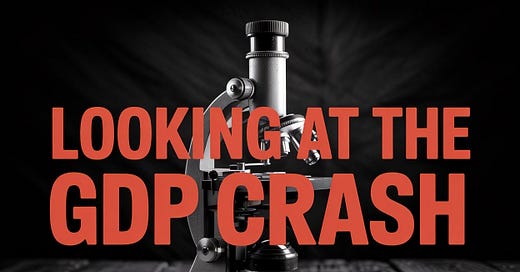This is an intelligence briefing on the opportunity created by the latest GDP report.
My thesis is simple: the market will wrongly panic over the illusory -0.5% contraction, while ignoring the consumer slowdown.
I'll show you exactly how to get paid from this panic with a specific trade.
How They Cook the Books
The entire negative print was caused by a single line item: a gargantuan 37.9% surge in imports.
Why?
Because companies are terrified of new tariffs, so they bought everything they could get their hands on before the taxes hit.
It’s a simple pull-forward of demand. The economic equivalent of your kid eating all their Halloween candy on October 31st. The sugar rush is intense, but the jar is empty in November.
Because GDP is a measure of domestic production, the government's formula has to subtract those imports. This one-time shopping spree made it look like our economy fell off a cliff.
It’s an accounting quirk. It’s not real.
The economists who are now tripping over themselves to predict a 3% bounce-back next quarter aren't fortune tellers — they just know the candy jar is empty and the import binge won't be repeated.
So, we take the -0.5% number and we throw it in the trash.
What’s actually happening, is buried on page three.
Consumer spending growth fell off a cliff, collapsing to just 0.5%.
That's down from 4% last quarter.
This is the signal.
Forget the GDP headline.
The American consumer, the engine of our entire economy, is scared and is finally putting their wallet away.
Why the Consumer Is the Only Thing
Consumer spending isn't just a part of the U.S. economy; for all practical purposes, it is the U.S. economy.
It accounts for nearly 70% of GDP.
When the consumer stops buying cars, refrigerators, and vacations, the entire machine grinds to a halt.
Corporate earnings vaporize.
Layoffs follow.
That 0.5% spending number is a flashing red light on the dashboard, and unlike the GDP figure, it isn't a faulty sensor.
It's the most reliable forward-looking indicator we have, and it's telling us to be cautious.
Our Response to Predictable Panic
When the market gets scared, it gets sloppy.
It sells good things along with the bad.
It creates volatility.
And for us, volatility is a raw material we use to create income.
I designed my system for moments exactly like this — to screen for world-class companies that get unfairly punished by headlines.
As an educational example, let’s look at a business like Lowe’s (LOW). It’s a tank.
But it lives and dies by the same consumer who is now showing signs of fear.
After this GDP report, the stock is likely under pressure.
The market is pricing in a consumer apocalypse.
This is where we act.
Here’s why a company like Lowe's passes VADER screen, even in this environment:
→ It’s Built to Last. Lowe’s is both a Dividend Aristocrat and a Dividend King, having lifted its payout for 60 straight years (well above the 25-year threshold).
→ It’s a Fortress. The company generates billions in free cash flow. In a downturn, it doesn't just survive; it has the firepower to bury weaker competitors.
→ It's Essential. Lowe’s operates in a home-improvement duopoly, providing the critical goods needed to maintain the country's single largest asset class: people's homes.
The market’s fear makes the options on a stock like LOW artificially expensive.
That’s an opportunity for us as sellers.
Let's say the stock has been knocked down to $222 a share.
We can respond by selling a put option with a $200 strike price that expires in 45 days. For selling that contract, we can demand a cash premium of, say, $4.00 a share.
That’s $400 in cash, per contract, deposited in our account today.
Now we wait.
If LOW stays above $200, the option expires worthless. We keep the $400. We just generated an annualized yield of over 16% on our secured cash. We then run the play again.
If LOW falls below $200, we are forced to buy 100 shares of a Dividend King at our chosen price of $200. This is a significant discount to where it was before the panic began. Now we own a great asset at a great price, and we can begin selling covered calls to generate our next stream of income.
A Note on Risk
This risk note isn’t just for the lawyers.
I’ve been on the wrong side of a trade where the "weakness was more severe than anticipated."
The primary danger here is that the consumer cuts back so hard it triggers a real market downturn, pushing LOW well below our $200 strike price.
In that scenario, we’d be looking at a paper loss.
This is why the system is so disciplined.
We only run this play on companies we are genuinely willing to own for the long haul.
Chasing premium on junk companies is how you get wiped out.
What I'm Watching Next
This is the whole game.
Ignoring the narrative, isolating the real data, using a disciplined system to monetize the resulting panic.
Moving forward, I'll be ignoring the inevitable Q2 GDP "bounce-back".
It’s just as meaningless as the Q1 contraction.
The only numbers I'll be watching are the monthly retail sales figures and the next consumer confidence report from the Conference Board.
That’s where the real story will unfold. And that’s where we’ll find our next opportunity.









Is the 200 strike a misprint? 220 is currently 3.80 or so and the 200 strike was 4 back on 5/7.
Excellent lesson:
Distill the signal from noisy data --> Screen for durability --> Exploit volatility --> Stay selective and disciplined.
This is attractive because:
You're buying the dip only if assigned.
A high yield is secured if not.
Thank you!